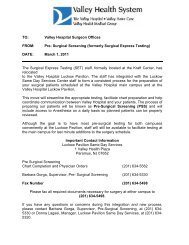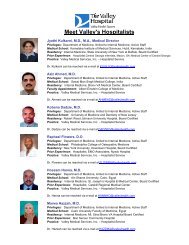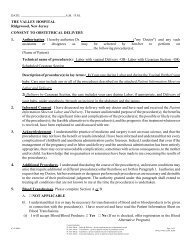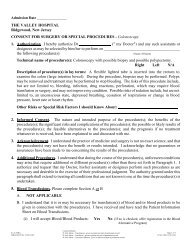Innovations - Valley Hospital
Innovations - Valley Hospital
Innovations - Valley Hospital
You also want an ePaper? Increase the reach of your titles
YUMPU automatically turns print PDFs into web optimized ePapers that Google loves.
T H E B L U M E N T H A L C A N C E R C E N T E R<br />
O u t c o m e s a n d<br />
<strong>Innovations</strong><br />
•<br />
2010
The <strong>Valley</strong> <strong>Hospital</strong> Cancer Committee<br />
Physician Members<br />
Robert Korst, M.D.;<br />
Chairman/ACoS Liaison; Medical Director,<br />
Cancer Center; Director, Thoracic Surgery<br />
Anusak Yiengpruksawan, M.D.;<br />
Vice Chairman; Director, Institute for<br />
Robotic and Minimally Invasive Surgery<br />
Arthur Antler, M.D.,<br />
Gastroenterology<br />
William Boss, Jr., M.D.,<br />
Plastic Surgery<br />
Harold Bruck, M.D.,<br />
Surgery<br />
William Burke, M.D.,<br />
Gynecologic Oncology<br />
Allen Chinitz, M.D.,<br />
Medical Oncology<br />
Anthony D’Ambrosio, M.D.,<br />
Neurosurgery<br />
Chad DeYoung, M.D.,<br />
Radiation Oncology<br />
Barry Fernbach, M.D.,<br />
Medical Oncology<br />
Howard Frey, M.D.,<br />
Urology<br />
Ganepola A.P. Ganepola, M.D.,<br />
Surgery<br />
Noah Goldman, M.D.,<br />
Gynecologic Oncology<br />
Andrey Gritsman, M.D.,<br />
Pathology<br />
Lawrence Harrison, M.D.,<br />
Surgical Oncology<br />
George Kaptain, M.D.,<br />
Neurosurgery<br />
Eli Kirshner, M.D.,<br />
Medical Oncology<br />
Laura Klein, M.D.,<br />
Breast Surgery<br />
Benjamin Lee, M.D.,<br />
Thoracic Surgery<br />
Linda Susan Marcus, M.D.,<br />
Dermatology<br />
Thomas Rakowski, M.D.,<br />
Medical Oncology<br />
Louis Rambler, M.D.,<br />
Diagnostic Imaging<br />
Arnold Scham, M.D,<br />
Psychiatry/Palliative Care<br />
Maria Scibetta, M.D.,<br />
Internal Medicine/Family Practice<br />
Howard Seigerman, M.D.,<br />
Diagnostic Imaging<br />
Metin Taskin, M.D.,<br />
Pathology<br />
Robert Tassan, M.D.,<br />
Medical Oncology<br />
Michael Wesson, M.D.,<br />
Radiation Oncology<br />
Staff Members<br />
Sandy Balentine, Director,<br />
Clinical Oncology<br />
Nancy Barrett-Fajardo, Manager,<br />
Inpatient Oncology<br />
Chaplain Cynthia Brady,<br />
Pastoral Care<br />
Margarita Conde, CTR,<br />
Tumor Registrar<br />
Veronica Dalcero, Social Worker,<br />
Oncology<br />
Peter Diestel, Senior Vice President,<br />
Administration, Chief Operating Officer<br />
Moises Junchaya,<br />
Oncology Pharmacist<br />
Sonia Kleiner-Arje, Director,<br />
Oncology Clinical Trials/Research<br />
Nancy Librera, Assistant Vice President,<br />
Oncology Services, Cancer Registry Quality<br />
Coordinator<br />
Carlo Lupano, Manager,<br />
Pharmacy<br />
Kris MacMillan, Director,<br />
Hospice<br />
Lucelly Moreno, CTR, Tumor Registrar,<br />
Cancer Conference Coordinator<br />
Nancy Palumbo, Oncology Program Coordinator,<br />
Community Outreach Coordinator<br />
Deborah Panetta, Director,<br />
Radiation Oncology<br />
Kim Robles, Director,<br />
Quality Assessment/IRC<br />
Nina Rubin, Supervisor,<br />
Community Nutrition<br />
Sobieda Santana-Joseph, Manager,<br />
Oncology Services<br />
1
Dear Colleague:<br />
On behalf of the Daniel and Gloria Blumenthal Cancer Center, it is with great pride that I present this<br />
publication titled “Outcomes and <strong>Innovations</strong>” to you. In it, you will find important data related to several<br />
of the most prevalent forms of cancer treated at The <strong>Valley</strong> <strong>Hospital</strong>. At the Blumenthal Cancer Center,<br />
we believe that it is essential that both the public as well as physicians are aware of our own experience and<br />
results, as opposed to simply quoting the literature, as is frequently done at other institutions. In addition,<br />
technology and expertise in cancer care are rapidly evolving, and this publication enables us to relay important<br />
advances at The <strong>Valley</strong> <strong>Hospital</strong> with regard to the workup and treatment of cancer patients.<br />
I invite you to spend some time with this publication and share it with colleagues in your office. I would be<br />
happy to discuss any portion of this publication with you or answer any questions regarding our cancer program.<br />
My thanks go to the doctors and staff at the Blumenthal Cancer Center for all the efforts they have made<br />
to make <strong>Valley</strong> one of the strongest, most innovative and highest quality oncology programs in New Jersey.<br />
Sincerely,<br />
Robert J. Korst, M.D.<br />
Medical Director, Daniel and Gloria Blumenthal Cancer Center<br />
Director, Thoracic Surgery<br />
Editor, Outcomes and <strong>Innovations</strong> 2010<br />
201-634-5722 • korsro@valleyhealth.com<br />
1
2<br />
Above left: Robert J. Korst, M.D.,<br />
Medical Director, The Blumenthal<br />
Cancer Center and Director of Thoracic<br />
Surgery at The <strong>Valley</strong> <strong>Hospital</strong>.<br />
Benjamin Lee, M.D., Thoracic Surgeon<br />
Lung Cancer and Thoracic Surgery<br />
Under the direction of Robert Korst, M.D.,<br />
the Lung Cancer Center at The <strong>Valley</strong> <strong>Hospital</strong><br />
provides the most up-to-date and comprehensive<br />
program for patients with lung cancer, and<br />
even for those who are at risk for the disease.<br />
Decades ago, most patients with lung cancer<br />
did not survive longer than one year. Today’s<br />
tests and treatments are saving the lives of<br />
numerous people with this disease. Services<br />
such as endobronchial ultrasound, mutational<br />
analysis, stereotactic body radiosurgery, and<br />
minimally invasive surgical techniques such<br />
single-port VATS are enabling doctors to diagnose,<br />
stage and treat lung cancer with greater<br />
precision and higher cure rates than ever.<br />
Thoracic surgeons at <strong>Valley</strong>’s Lung Cancer<br />
Center now offer a new minimally invasive<br />
procedure for the detection and diagnosis of<br />
Thoracic surgery patient volume has increased<br />
steadily over the past four years, with volumes<br />
now approaching those seen at major academic<br />
centers. Last year, more than 600 procedures<br />
were conducted. Thoracic surgery at <strong>Valley</strong><br />
involves a comprehensive range of procedure<br />
types involving the lungs, esophagus, and other<br />
mediastinal structures.<br />
For more information, please call 201-634-5722.<br />
Number of procedures<br />
650<br />
600<br />
550<br />
500<br />
450<br />
400<br />
350<br />
300<br />
250<br />
200<br />
150<br />
100<br />
50<br />
0<br />
Mediastinum<br />
Esophagus<br />
early-stage lung cancer. The superDimension®<br />
lung navigation system enables surgeons to<br />
reach previously inaccessible lesions deep in<br />
the lungs by going through the mouth, as<br />
opposed to violating the patients’ skin with<br />
an incision or a needle.<br />
Finally, the importance of the Lung Cancer<br />
Screening Program at <strong>Valley</strong>’s Lung Cancer<br />
Center cannot be emphasized enough now that<br />
lung cancer screening using low dose computed<br />
tomography (LDCT) has been proven to reduce<br />
the risk of dying from lung cancer in a large,<br />
randomized clinical trial. Patients in whom lung<br />
nodules are found are managed in our dedicated<br />
Pulmonary Nodule Center, according to<br />
established protocols, saving the vast majority<br />
of patients any invasive procedures.<br />
The <strong>Valley</strong> <strong>Hospital</strong> Thoracic Surgery Procedures<br />
1<br />
Endoscopic procedures<br />
Lung/pleura/chest<br />
wall/diaphragm<br />
218 216<br />
30 3<br />
23<br />
187 190<br />
334<br />
34<br />
43<br />
22<br />
235<br />
493<br />
250<br />
501<br />
635<br />
2005 2006 2007 2008 2009 2010<br />
87<br />
96<br />
60<br />
125<br />
35<br />
268<br />
106<br />
73 221<br />
36<br />
272
Primary Malignancies of the Lung, Pleura and Trachea<br />
Undergoing Curative Resection in 2010<br />
Extended<br />
Resections 9%<br />
Open<br />
Lobectomy 9%<br />
VATS Wedge<br />
Resection 11%<br />
Complex/Extended Resections for Malignancies of the Lung,<br />
Pleura and Tracheobronchial Tree in 2010<br />
Pulmonary<br />
Arterioplasty<br />
Chest Wall<br />
Resection<br />
Extrapleural<br />
Pneumonectomy<br />
19% Myotomy<br />
23%<br />
Esophageal<br />
Cancer<br />
VATS Anatomic<br />
Segmentectomy 7%<br />
Bronchoplasty<br />
Bilobectomy<br />
Surgically Managed Esophageal Disease in 2010<br />
Single-Port<br />
VATS<br />
Lobectomy<br />
64%<br />
58%<br />
Hiatal<br />
Hernia<br />
Repair<br />
■ In 2010, <strong>Valley</strong>’s dedicated, non-cardiac, thoracic surgeons<br />
performed all types of resections for lung cancer. 91% of all<br />
lobectomies for early stage lung cancer were performed using<br />
the single-port VATS approach, which corresponded to 64% of<br />
all lung cancer resections. Single-port VATS is the most minimally<br />
invasive form of lung removal that can presently be accomplished,<br />
because all dissection is performed through one, 3-4 centimeter<br />
incision. Even robotic lung resections are more invasive than<br />
single-port VATS, requiring anywhere from 3-5 incisions, and<br />
sometimes even more.<br />
■ At the Lung Cancer Center, complex resections are also<br />
routinely performed including bronchoplasty, bilobectomy,<br />
extrapleural pneumonectomy, chest wall resection and<br />
pulmonary arterioplasty. These are for patients with more<br />
extensive tumors.<br />
■ Surgery remains an effective treatment modality for esophageal<br />
disease. In 2010, the predominant procedure performed was hiatal<br />
hernia repair, as it was in 2009. At <strong>Valley</strong>, esophageal resections<br />
for malignancy are approached using minimally invasive techniques<br />
when they are in their earliest stages. Many patients with very early<br />
cancers can be safely managed solely with endoscopic resections,<br />
requiring no incisions whatsoever. Further, <strong>Valley</strong> physicians have<br />
performed over 200 radiofrequency ablation (RFA) procedures<br />
for patients with Barrett’s Esophagus, a premalignant condition<br />
due to chronic gastroesophageal reflux. RFA has the ability to<br />
actually prevent patients from developing esophageal cancer.<br />
3
4<br />
Lung Cancer and<br />
Thoracic Surgery<br />
At three days, <strong>Valley</strong>’s 2010 average<br />
length of stay for lobectomy (performed<br />
in a video-assisted manner)<br />
compares favorably to the length of<br />
stay published from data obtained<br />
from the Society of Thoracic Surgeons<br />
National Database, where the length<br />
of stay for video-assisted lobectomy<br />
was four days.<br />
At <strong>Valley</strong>, the average length of stay<br />
for esophagectomy was seven days in<br />
2010, an improvement of one full day<br />
over 2009’s mark of eight days.<br />
Median Length of <strong>Hospital</strong> Stay in 2010<br />
VATS Lobectomy<br />
Continued<br />
Esophagectomy<br />
Open Lung Cancer Resection<br />
VATS Segmentectomy<br />
VATS Wedge Resection<br />
Esophageal Myotomy<br />
Hiatal Hernia Repair<br />
0 1 2 3 4 5 6 7 8<br />
Median Length of stay (days)<br />
Laura A. Klein, M.D.,<br />
Medical Director,<br />
The <strong>Valley</strong> <strong>Hospital</strong> Breast Center<br />
Breast Cancer<br />
Breast cancer services are under the direction<br />
of Laura Klein, M.D. Board-certified in general<br />
surgery, Dr. Klein completed her training in<br />
a specific breast fellowship program emphasizing<br />
oncoplastic techniques. These techniques<br />
apply to women who undergo breast conserving<br />
resections (“lumpectomies”). By combining<br />
breast resection with plastic surgical principles,<br />
oncoplasty results in the best cosmetic results.<br />
Prior to coming to the Blumenthal Cancer<br />
Center, Dr. Klein was on staff at Columbia-<br />
Presbyterian Medical Center. Her special<br />
interests include breast cancer in young<br />
women, DCIS (ductal carcinoma in situ),<br />
novel approaches to breast cancer treatment, and<br />
patients at high risk for developing breast cancer.<br />
The Breast Center at The <strong>Valley</strong> <strong>Hospital</strong> offers all the services a woman needs for<br />
total breast care. Services include: digital diagnostic and screening mammography,<br />
breast MRI, ultrasound core biopsy, cyst aspiration, fine needle aspiration,<br />
stereotactic breast biopsy, and tomosynthesis.<br />
<strong>Valley</strong> holds a three-year accreditation designation by the National Accreditation<br />
Program for Breast Centers (NAPBC), a program administered by the American<br />
College of Surgeons, and is designated a Breast Imaging Center of Excellence by<br />
the American College of Radiology.<br />
For more information, please call 201-634-5557.<br />
“<br />
Oncoplasty merges the disciplines of<br />
breast cancer surgery with plastic surgery<br />
for the best cosmetic result.<br />
”
InSitu<br />
2010 Review of Analytic<br />
Breast Cancer Cases<br />
Stage of Diagnosis<br />
Stage I<br />
Stage II<br />
Stage III<br />
Stage IV<br />
Unknown<br />
Total<br />
500<br />
400<br />
300<br />
200<br />
100<br />
0<br />
292<br />
128<br />
176<br />
92<br />
16<br />
19<br />
17<br />
448<br />
Breast Cancer: Total Case Volume<br />
360<br />
■ Stage distribution of breast cancer<br />
cases at the Blumenthal Cancer Center<br />
in 2010. As shown, the majority of breast<br />
cancer is diagnosed in its early, curable<br />
stages, reflecting a rigorous, successful early<br />
detection program at The <strong>Valley</strong> <strong>Hospital</strong>.<br />
448<br />
2008 2009 2010<br />
“<br />
Tomosynthesis generates a 3-D image<br />
of the breast and can help radiologists<br />
rule out abnormalities that may have<br />
looked suspicious in a 2-D mammogram,<br />
reducing the need, in some cases, for<br />
women to receive additional imaging<br />
or biopsies.<br />
”<br />
■ The clinical volume of breast cancer cases<br />
at the Blumenthal Cancer Center has been<br />
rising rapidly over the past three years.<br />
We attribute this to the realization of the<br />
benefits of oncoplastic surgical techniques<br />
in the management of this disease.<br />
5
6<br />
From Left: Noah A. Goldman, M.D.,<br />
Gynecologic Surgical Oncologist<br />
and William M. Burke, M.D.,<br />
Director of Gynecologic Oncology<br />
Gynecologic Oncology<br />
William M. Burke, M.D., and Noah A. Goldman,<br />
M.D., have more than 25 years of combined<br />
experience with open surgical and laparoscopic<br />
procedures.<br />
Their pioneering work with robotics and the<br />
da Vinci Surgical System has made The <strong>Valley</strong><br />
<strong>Hospital</strong>’s Institute for Robotic and Minimally<br />
Invasive Surgery a leader in minimally invasive<br />
procedures performed robotically.<br />
Our physicians are nationally recognized for<br />
their contributions to the field of robotic<br />
gynecologic surgery, which is reflected in their<br />
regular participation in web-based live surgical<br />
demonstrations.<br />
In 2010 Drs. Burke and Goldman conducted a<br />
live, televised demonstration of a robot-assisted<br />
hysterectomy to 400 gynecologists in Croatia.<br />
The telesurgery was broadcast to attendees<br />
of the American Association of Gynecologic<br />
Laparoscopists’ (AAGL) Fourth International<br />
Congress on Minimally Invasive Gynecologic<br />
Surgery in Dubrovnik.<br />
The two gynecologic oncologists used the<br />
da Vinci® system to remove the patient’s uterus<br />
For more information, please call 201-634-5401.<br />
through several small half-inch incisions on<br />
her abdomen rather than a traditional large<br />
abdominal incision. The patient spent just<br />
one night in the hospital.<br />
Early gynecologic cancer, whether it is ovarian,<br />
endometrial, cervical, or uterine, can be<br />
approached in a minimally invasive fashion.<br />
In addition to smaller incisions and often<br />
shorter recovery times, minimally invasive<br />
approaches to cervical and ovarian cancer<br />
offer another important advantage for women<br />
who hope to have children – fertility can often<br />
be spared through preservation of the uterus.<br />
Approximately 50 percent of the gynecologic<br />
procedures performed using robotic surgery<br />
are for benign conditions such as fibroids,<br />
bleeding, endometriosis, and cervical dysplasia.<br />
Robotic procedures performed include:<br />
myomectomy, resection of endometriosis,<br />
hysterectomy and radical hysterectomy<br />
(in both cases with or without removing<br />
the fallopian tubes), radical trachelectomies,<br />
and staging procedures for uterine, cervical<br />
and ovarian cancer, which include lymph<br />
node dissections and omentectomies.<br />
“ <strong>Valley</strong> physicians are nationally recognized<br />
for their contributions to the field of robotic<br />
gynecologic surgery.<br />
”
Number of Procedures<br />
600<br />
500<br />
400<br />
300<br />
200<br />
100<br />
0<br />
Gynecologic Oncology Operative Procedures<br />
Total Operative Procedures<br />
Robotic Operative Procedures<br />
2006 2007 2008 2009 2010<br />
Year<br />
Endometrial Carcinoma: 2010 Surgical Outcomes<br />
% of patients offered minimally invasive procedure<br />
Average operative time<br />
Conversion to open procedure<br />
% of patients with pelvic lymph nodes sampled<br />
% of patients with para-aortic lymph nodes sampled<br />
Length of hospital stay<br />
96%<br />
98 minutes<br />
2%<br />
90%<br />
52%<br />
1.25 days<br />
■ As shown, the number of surgical<br />
cases performed robotically has<br />
risen steadily since 2006. Last year,<br />
more than 200 of the year’s 529<br />
cases were performed using the<br />
robotic, da Vinci Surgical System.<br />
Total operative procedures have<br />
also risen with a new high reached<br />
last year.<br />
■ These statistics provide a glimpse<br />
inside the <strong>Valley</strong> robotic surgical<br />
program for endometrial carcinoma,<br />
the most common surgically treated<br />
gynecologic malignancy. The average<br />
robotic operative time was 1 hour,<br />
38 minutes (98 minutes), and in only<br />
2% of cases was a conversion to<br />
an open procedure required. The<br />
average length of hospital stay for<br />
patients was a mere 1.25 days.<br />
7
8<br />
Anusak Yiengpruksawan, M.D.,<br />
Director, The Institute for Robotic and<br />
Minimally Invasive Surgery<br />
Lawrence E. Harrison, M.D.,<br />
Director of Surgical Oncology<br />
Pancreatic and Hepatobiliary Cancer<br />
Led by Anusak Yiengpruksawan, M.D.,<br />
(Dr. Yieng), Director of The Institute for<br />
Robotic and Minimally Invasive Surgery,<br />
and Lawrence E. Harrison, M.D., Director<br />
of Surgical Oncology, <strong>Valley</strong> offers a wide<br />
range of surgical options for patients with<br />
pancreatic or hepatobiliary cancer.<br />
Dr. Yieng performed the first fully robotic<br />
Whipple procedure in the United States.<br />
The Whipple is a sophisticated procedure<br />
used to remove tumors of the pancreas.<br />
The operation generally involves removal<br />
of the gallbladder, bile duct, part of the<br />
small intestine, and head of the pancreas.<br />
Dr. Yieng is internationally recognized for<br />
his skills in endoscopic ultrasound, minimally<br />
invasive surgery, and robotic surgery. He was<br />
one of the first surgeons in New Jersey to<br />
use the da Vinci® Surgical System to remove<br />
the spleen, adrenal glands, and tumors of the<br />
stomach, pancreas, and esophagus.<br />
■ As seen here, the number of cases of pancreatic<br />
cancer treated at <strong>Valley</strong> has risen steadily since 2005.<br />
Dr. Harrison directs New Jersey’s only HIPEC<br />
(Hyperthermic Intraperitoneal Chemotherapy)<br />
program. HIPEC involves delivering chemotherapy<br />
to the abdominal area immediately after a<br />
cancerous tumor(s) has been removed during<br />
cytoreductive surgery. While the patient remains<br />
on the operating table under anesthesia, the<br />
open abdomen is bathed with a high dose of<br />
warmed chemotherapy for 90 minutes. The<br />
medication is then drained from the patient,<br />
the incision is closed, and the patient is moved<br />
to a recovery area.<br />
In a testament to the complex nature of the<br />
broad based, minimally invasive surgical expertise<br />
at <strong>Valley</strong> and the Blumenthal Cancer Center,<br />
<strong>Valley</strong>’s surgeons are also involved in training<br />
future surgeons in these techniques. The<br />
<strong>Valley</strong> <strong>Hospital</strong> Fellowship in Minimally<br />
Invasive/Robotic Surgery and Interventional<br />
Endoscopy is a nationally recognized, accredited<br />
program aimed at teaching other surgeons these<br />
complex approaches.<br />
To contact Dr. Yiengpruksawan, please call 201-634-5438. To contact Dr. Harrison, please call 201-634-5547.<br />
Pancreatic Cancer: Total Case Volume
Pancreas/Liver/Bile Duct Resections<br />
Liver &<br />
Bile Duct<br />
Distal<br />
Pancreatectomy<br />
Whipple<br />
Procedure<br />
Liver/Bile Duct Resections<br />
Bile Duct<br />
Resection<br />
Liver<br />
Lobectomy<br />
Partial<br />
Liver<br />
Resection<br />
■ This comparison of open vs. robotic<br />
procedures shows predominant use of<br />
the minimally invasive, robotic<br />
technique for distal pancreatectomy<br />
and liver/bile duct resection.<br />
■ The types of resections for tumors<br />
of the pancreas and liver in 2010<br />
were fairly evenly distributed<br />
between the Whipple procedure,<br />
distal pancreatectomy and liver/bile<br />
duct resection.<br />
■ Of the hepatobiliary resections,<br />
partial liver resections were the<br />
predominant form at <strong>Valley</strong> in 2010.<br />
Pancreas/Liver/Bile Duct Resections<br />
Robotic Versus Open Procedures<br />
9
10<br />
Anthony D’Ambrosio, M.D.<br />
Director, Neuro-Oncology Disease<br />
Management Team, and Co-Director,<br />
The Gamma Knife Center<br />
Neuro-Oncology<br />
In 2010, the Blumenthal Cancer Center<br />
established The Institute for Brain and Spine<br />
Radiosurgery for patients with malignant and<br />
benign conditions of the brain and spinal cord.<br />
The Institute is led by Anthony D’Ambrosio,<br />
M.D., Director of the Neuro-Oncology Disease<br />
Management Team. In addition, The Brain<br />
Metastasis Center was also developed as a service<br />
exclusively aimed at providing high quality,<br />
state-of-the-art care for patients with cancers<br />
which have spread to the brain from other sites.<br />
In both of these programs, patients benefit<br />
from a multidisciplinary approach that integrates<br />
the skills and expertise of many different<br />
specialists, with only one office visit for the<br />
patient. The physicians, surgeons, and other<br />
professionals who comprise the Institute have<br />
many years of experience in treating these<br />
brain and spinal diseases and are engaged<br />
in cutting-edge research to expand treatment<br />
options and improve patients’ quality of life<br />
during and after treatment.<br />
■ In the past three years, an increasing number<br />
of patients with brain tumors sought treatment<br />
using stereotactic radiosurgery, a highly precise,<br />
non-surgical modality. Last year saw a new<br />
volume high: 56 patients treated using either<br />
surgery, radiosurgery or a combination thereof.<br />
For more information, please call 201-634-5585.<br />
The team includes neurologists, neurosurgeons,<br />
medical oncologists, radiation oncologists,<br />
pathologists, neuro-radiologists, a neuropsychologist,<br />
and a highly skilled nursing team.<br />
At our new Gamma Knife Center, a nurse<br />
navigator assists patients from their first<br />
phone call through treatment and follow-up.<br />
Gamma knife radiosurgery is an effective, nonsurgical<br />
treatment for cancer and neurological<br />
conditions in the brain. The technology is neither<br />
a “knife” nor “surgery” in the traditional sense<br />
of those words. No incisions are made and<br />
there is no overnight stay in a hospital or extended<br />
recuperation period.<br />
<strong>Valley</strong>’s physicians, who have treated thousands<br />
of patients and have more than 10 years of<br />
experience, use the Leksell Gamma Knife Perfexion<br />
to treat tumors such as: acoustic neuromas, astrocytomas,<br />
craniopharyngiomas, gliomas, meningiomas,<br />
metastatic brain tumors, pineal tumors,<br />
pituitary tumors, and skull base tumors.<br />
Brain Tumors<br />
Surgical Resection Versus Stereotactic Radiosurgery
Howard Frey, M.D., Medical Director,<br />
The Center for Prostate Cancer<br />
Saurabh Agarwal, M.D.,<br />
Medical Director, Robotic Urology<br />
Prostate and Genitourinary<br />
Center for Prostate Cancer<br />
The Center for Prostate Cancer brings together<br />
a multifaceted team of experts led by Medical<br />
Director Howard Frey, M.D. The team consists<br />
of a medical oncologist, radiation oncologist,<br />
surgeon, urologist, registered dietitian, complementary<br />
medicine specialist, nurse and social<br />
worker. This team provides a multidisciplinary<br />
approach to treating prostate cancer.<br />
During a visit to the Center, the patient visits<br />
with a team of physician experts to discuss<br />
appropriate treatment options. In addition,<br />
the patient confers with ancillary team members<br />
to discuss support services such as nutrition and<br />
education to receive pertinent information.<br />
The physician experts confer, and then<br />
formulate an integrated recommendation<br />
for treatment that is delivered to the patient.<br />
Patients are referred by their primary care<br />
physician, urologist or through self-referral.<br />
■ The median length of stay after robotic radical<br />
prostatectomy at the <strong>Valley</strong> <strong>Hospital</strong> was slightly<br />
more than one day in 2010.<br />
For more information, please call 201-634-5567.<br />
■ The percentage of patients with positive surgical<br />
margins after robotic radical prostatectomy at <strong>Valley</strong><br />
was 16.2%. The best observed national average was 34%.<br />
Robotic Urology<br />
Saurabh Agarwal, M.D., is Medical Director<br />
of Robotic Urology at <strong>Valley</strong>’s Institute for<br />
Robotic and Minimally Invasive Surgery.<br />
Since 2006, Dr. Agarwal has performed hundreds<br />
of procedures using the da Vinci Surgical System,<br />
making him one of the most experienced robotic<br />
surgeons in the area. It was his success with<br />
prostate surgery that inspired him to discover<br />
new uses for the da Vinci System.<br />
He became the first surgeon in the area to<br />
use the da Vinci System to perform a partial<br />
nephrectomy, a highly advanced procedure<br />
for the treatment of kidney cancer. He is<br />
also one of few surgeons performing prostate<br />
surgery without cauterization, resulting in<br />
better outcomes and quicker recovery times.<br />
2010 Analytic Prostate Cases<br />
Stage of Diagnosis<br />
Stage I<br />
Stage II<br />
Stage III<br />
Stage IV<br />
Unknown<br />
9<br />
121<br />
11<br />
8<br />
4<br />
11
12<br />
Recent Cancer Center Publications Research<br />
Boonnuch W, Akaraviputh T, Carnevale N,<br />
Yiengpruksawan A, Christiano AA.<br />
Successful treatment of esophageal metastasis<br />
from hepatocellular carcinoma using the da Vinci<br />
robotic surgical system. World J Gastrointest Surg<br />
2011;27:82-5.<br />
Burke WM, Gossner G, Goldman NA.<br />
Robotic surgery in the obese gynecologic<br />
patient. Clin Obstet Gynecol 2011;54:420-30.<br />
D’Ambrosio AL, DeYoung C, Isaacson SR.<br />
Radiosurgical management of brain metastases.<br />
Neurosurg Clin N Am 2011;22:45-51.<br />
Jha A, Yiengpruksawan A, Christiano AA,<br />
Jha N, Latika P. Actinomycosis of the pancreas:<br />
a case report and review. Gastroenterol Res<br />
2010;3:134-8.<br />
Kella VK, Shakov E, Yiengpruksawan A.<br />
Laparobotic duodenal diverticulectomy and<br />
choledochoduodenostomy: a case study and<br />
review of the literature. J Robot Surg 2010;3:249-52.<br />
Kellner CP, D’Ambrosio AL. Surgical<br />
management of brain metastases. Neurosurg<br />
Clin N Am 2011;22:53-9.<br />
Korst RJ, Kansler AL, Christos PJ, Mandal S.<br />
Adjuvant radiotherapy for thymic epithelial<br />
tumors: a systematic review and meta-analysis.<br />
Ann Thorac Surg 2009;87:1641-7.<br />
Korst RJ, Lee BE, Krinsky GA, Rutledge JR.<br />
The utility of automated volumetric growth analysis<br />
in a dedicated pulmonary nodule clinic. J Thorac<br />
Cardiovasc Surg 2011;142:372-7.<br />
Korst RJ, Santana-Joseph S, Rutledge JR,<br />
Antler A, Bethala V, DeLillo A, Kutner D,<br />
Lee BE, Pazwash H, Pittman RH, Rahmin M,<br />
Rubinoff M. Effect of hiatal hernia size and<br />
columnar segment length on the success of<br />
radiofrequency ablation for Barrett’s esophagus:<br />
a single-center, phase II clinical trial. J Thorac<br />
Cardiovasc Surg 2011;142:1168-73.<br />
Kutner MA, Bromberg A, Korst RJ, Lee BE.<br />
An unusual case of dysphagia from intrathoracic<br />
liver. Ann Thorac Surg 2010;90:e54-5.<br />
Raman SR, Shakov E, Carnevale N, Yiengpruksawan<br />
A. Robotic adrenalectomy by an open<br />
surgeon: are outcomes different? J Robot Surg<br />
[Internet] 2011;http://dx.doi.org/10.1007/s11701-<br />
011-0292-5<br />
Yiengpruksawan, A. Technique for laparobotic<br />
distal pancreatectomy with preservation of spleen.<br />
J Robot Surg 2011;5:11-5<br />
Frey HL, Chang D. Clinical application of molecular<br />
profiling using urine, blood, and tumor tissue for<br />
identification of biomarkers in urothelial carcinoma.<br />
Ganepola GAP, Suman P. Genomic solutions<br />
for managing colon cancer.<br />
Ganepola GAP, Suman P, Yiengpruksawan A,<br />
Chang D. Identification microRNA biomarkers for<br />
early diagnosis of pancreatic cancer.<br />
Klein l, Ganepola GAP, Suman P, Chang D.<br />
Identification of microRNA biomarkers for risk<br />
stratification of breast cancer.<br />
Korst RJ, Lee B, Chang D. Analysis of gene<br />
expression in peripheral blood mononuclear<br />
cells in lung cancer.<br />
Korst RJ, Lee B, Chang D. Gene expression<br />
patterns in indolent versus aggressive non-small<br />
cell lung cancer less than 3 centimeters in size.
National Presentations<br />
Burke WM. Haptics or happenstance: a case<br />
presentation on a robotic vascular injury during<br />
gynecologic oncology surgery. Presented at the<br />
World Robotic Gynecology Congress III and International<br />
Gynecologic Oncology Robotic Symposium<br />
IV, Washington D.C., May 4-5, 2011.<br />
Burke WM. How to build a successful gynecologic<br />
robotics program. Presented at the World<br />
Robotic Gynecology Congress III and International<br />
Gynecologic Oncology Robotic Symposium<br />
IV, Washington D.C., May 4-5, 2011.<br />
Ganepola, GAP. Proteome analysis of pancreatic<br />
cancer tissue for identification of novel biomarkers.<br />
Presented at the 1st AACR International Conference<br />
on Frontiers in Basic Cancer Research, Boston, MA,<br />
October 8-11, 2009.<br />
Korst RJ, Chang DH, Augenlicht LH, Rutledge<br />
J, Lee BE. Interleukin 1 beta gene expression in<br />
peripheral blood mononuclear cells as a marker<br />
for stage 1 lung cancer. Presented at the 91st<br />
Annual Meeting of the American Association for<br />
Thoracic Surgery; Philadelphia, PA, May 9, 2011.<br />
Lee BE, Korst RJ, Kletsman E. Replacing<br />
mediastinoscopy with endobronchial ultrasound:<br />
a community thoracic surgeon’s perspective.<br />
Presented at the 37th Annual Meeting of the<br />
Western Thoracic Surgical Association, Colorado<br />
Springs, CO, June 24, 2011.<br />
Needham J, Yiengpruksawan A. Local resection<br />
of tumors at or around gastroesophageal junction<br />
(juxta-GEJ tumors). Presented at the 2nd Annual<br />
Meeting of the Clinical Robotic Surgery Association,<br />
Chicago, IL, October, 2010.<br />
Suman P, Ganepola GAP. Autophagy in<br />
colorectal cancer. Presented at the Annual<br />
Scientific Meeting of the Medical Society of<br />
the State of New York, April 8-10, 2011.<br />
Yiengpruksawan A. Pearls: complication and<br />
unusual cases teaching points. Presented at the<br />
5th Annual World Robotic Symposium, Orlando,<br />
FL, April, 2010.<br />
Yiengpruksawan A. Robotic palliative procedures.<br />
Presented at the 5th Annual World<br />
Robotic Symposium, Orlando, FL, April, 2010.<br />
Yiengpruksawan A. Robotic spleen preserving<br />
pancreatectomy. Presented at the 6th Annual<br />
World Robotic Symposium, Miami Beach, FL,<br />
June, 2011.<br />
Yiengpruksawan A. The Whipple procedure –<br />
the way I do it. Presented at the 5th Annual<br />
World Robotic Symposium, Orlando, FL, April, 2010.
No hospital in the nation has more Gold Seals of Approval<br />
for cancer care than The <strong>Valley</strong> <strong>Hospital</strong>.<br />
Breast. Colorectal. Lung. Pancreatic and Prostate.<br />
The Daniel and Gloria Blumenthal Cancer Center<br />
One <strong>Valley</strong> Health Plaza, Paramus, NJ 07652<br />
www.<strong>Valley</strong>HealthCancerCenter.com • 201.634.5339

















